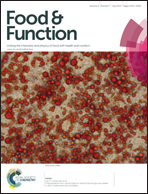Effect of tannic acid–fish scale gelatin hydrolysate hybrid nanoparticles on intestinal barrier function and α-amylase activity
Abstract
Practical application of tannic acid is limited because it readily binds proteins to form insoluble aggregates. In this study, tannic acid was self-assembled with fish scale gelatin hydrolysates (FSGH) to form stable colloidal complex nanoparticles. The nanoparticles prepared from 4 mg ml−1 tannic acid and 4 mg ml−1 FSGH had a mean particle size of 260.8 ± 3.6 nm, and showed a positive zeta potential (20.4 ± 0.4 mV). The nanoparticles acted as effective nano-biochelators and free radical scavengers because they provided a large number of adsorption sites for interaction with heavy metal ions and scavenging free radicals. The maximum adsorption capacity for Cu2+ ions was 123.5 mg g−1 and EC50 of DPPH radical scavenging activity was 21.6 ± 1.2 μg ml−1. Hydroxyl radical scavenging effects of the nanoparticles were investigated by electron spin resonance spectroscopy. The copper-chelating capacity and free radical scavenging activity of the nanoparticles were associated with their capacity to inhibit Cu2+ ion-induced barrier impairment and hyperpermeability of Caco-2 intestinal epithelial tight junction (TJ). However, α-amylase inhibitory activity of the nanoparticles was significantly lower than that of free tannic acid. The results suggest that the nanoparticles can ameliorate Cu2+ ion induced intestinal epithelial TJ dysfunction without severely inhibiting the activity of the digestive enzymes.


 Please wait while we load your content...
Please wait while we load your content...